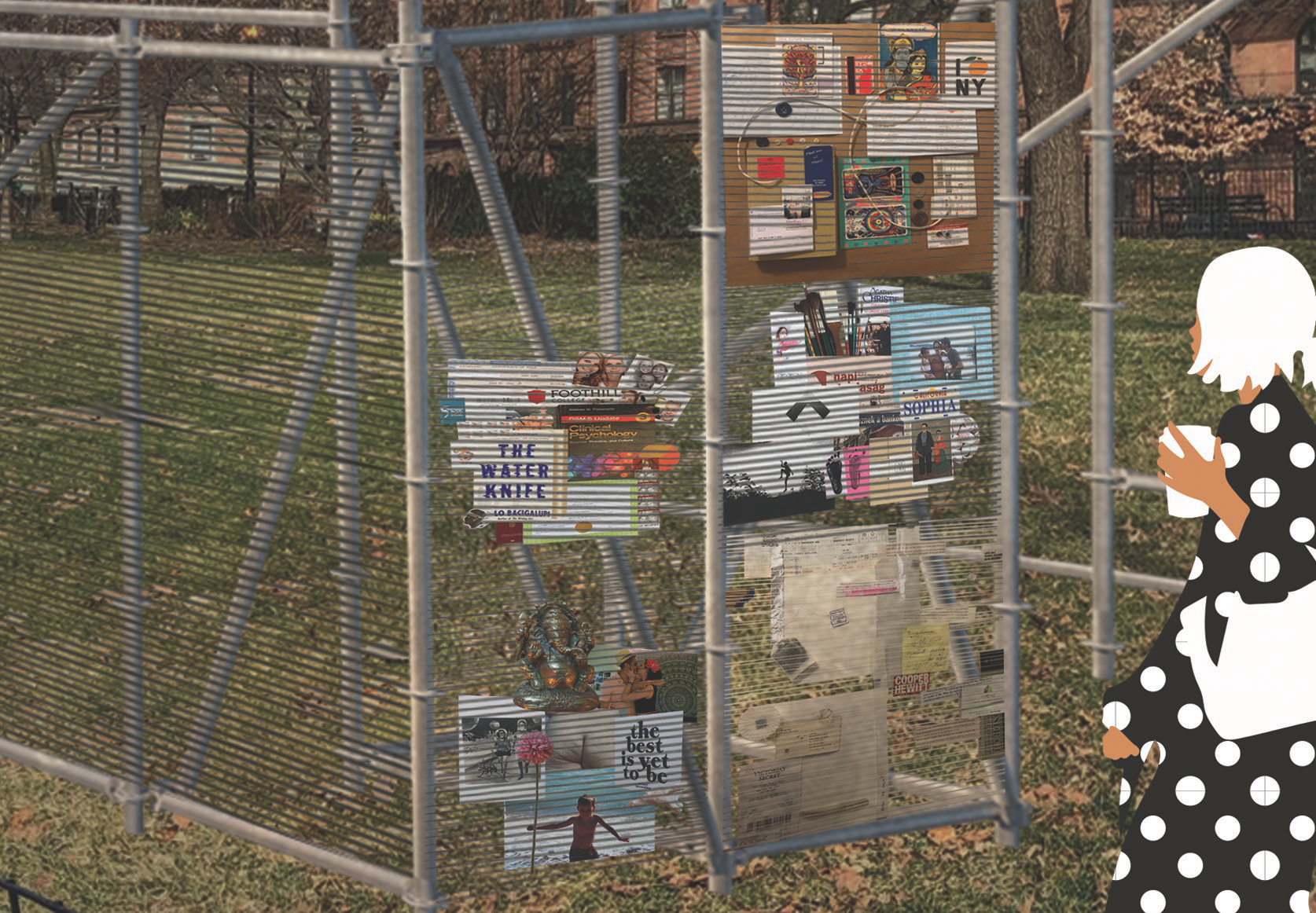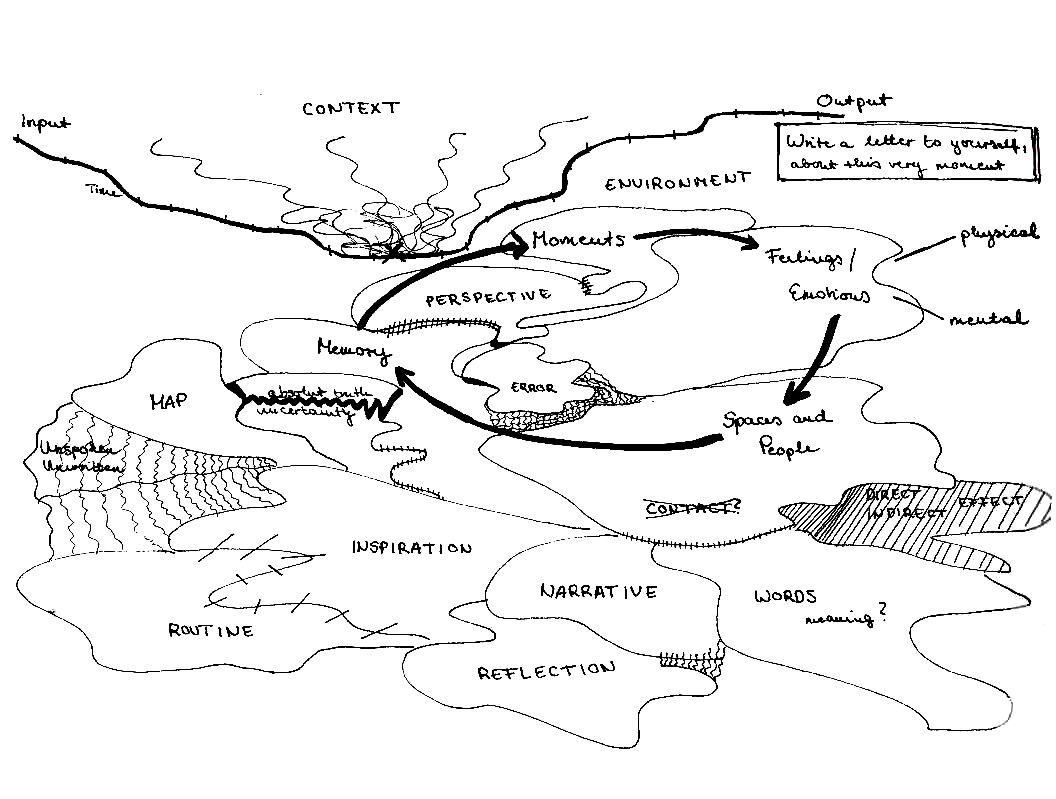
Co-
Co-
A Parsons School of Design Project
New York, New York
Interiority is constituted not only as a space, but the inner self of an individual: a very private state of mind, your inner thoughts and feelings. The essential value of interiority is storytelling by adding value to objects and spaces through human interaction. “Our identity informs the places we inhabit while conversely our engagement with those places help to define our sense of self.”
In order to explore the activation of spaces through human placemaking, “defined as any means of enriching an environment through adding to its sense of place”, I have investigated the solitary creative practices as a mode of creating a personal interior that exists outside the commodified version of self-care prevalent today. While searching for creative methods supporting the personal well-being of an individual, I realized that the need for developing self-awareness, with the aim of contributing to the community, is often overlooked.
I am proposing a temporal installation created through community participation in NYC, which investigates my research question: How can a shared experience of mindful creative making bring together a community and foster collective mental wellbeing?
Millennials are suffering from anxiety and burnout caused by difficult economic circumstances, so it is logical that self-care ia a popular aspiration of today’s society. Mental health is a topic that affects all of us on a day to day basis across different classes and social systems. With the popularity of self-care, companies have been quick to capitalize on the movement. However, the costly wellness industry has its limitations and self-care products offerings (Goop Inc.) are not affordable for people from lower income social classes.
Hence, I am introducing an alternative form of self-care available for any individual, a method of practicing mindfulness through creative engagement with the existing objects in one’s surroundings. In our daily lives, conscious and unconscious thoughts define our actions, patterns and mental well-being. Looking more closely at the objects we engage with, the way these objects mark the time and the ordinary events of our lives may shift our approach to ourselves, our environment and our human interactions. The individuals interested in developing self-awareness through participating in the community installation, are collecting every day items, such as checks, diapers, notes etc. and weaving them together with sentimental items like photographs, postcards and letters etc. from significant periods of their life to create a new value in those objects- the collaboration becomes a piece of art.
As stated by Suzanne Nalbantian “the work of art is the production of the human brain, it is an “artifact” engaged in a definite mode of intersubjective communication between individuals within the social group. It communicates a social message, with strong emotional and evocative power to the human community. The symbolic content of an art piece seeks to associate emotion and reason in a unique and synthetic manner, creating a state of catharsis.” The idea of my thesis is to facilitate the catharsis within the individual to generate ideas beyond the utility of these items surrounding them, to support mindful living, fostering a sense of being present in the moment.
How can a shared experience of mindful creative making bring together a community and foster collective mental wellbeing?
Research: Goop Inc.
Goop Inc., Gwyneth Paltrow’s lifestyle brand is best known as an online platform for luxury goods. Yet, to the surprise of the medical community, the company has become the epicenter of the multi-trillion-dollar wellness industry.
This market spans everything from mind-body fitness to preventative medicine to spa tourism, however their integrity is questionable. In the past years the company faced criticism for promoting health products that lack evidence of medical benefit. Moreover, instead of questioning long-standing assumptions about women’s bodies, as Goop often claims, the companies products embrace one of America’s oldest health myths: that physical beauty is proof to not only of a person’s health but of her essential righteousness.
Goop Inc. serves as an example of the commodification of self-care and proves that costly wellness products benefits are limited to higher-income social classes.
Research: The Alchemist Kitchen
The Alchemist Kitchen represents a different type of self-care, their value lies in the dedication to connect consumers with the power of plants. The artisan products celebrate the importance of sustainability and conscious living. Through my conversation with one of the herbalists on the role of suppliers I realized that the small farm-based operations are strongly connected to the storytelling of the brand.
While searching for creative methods supporting the personal well-being of an individual, I realized that the need for developing self-awareness, with the aim of contributing to the community, is often overlooked.
Research through Experimentation: Saori Weaving
In terms of designing “Co-“, weaving serves as a conceptual net of stories told by common objects, events of one’s current life. To learn the basics of weaving, I have explored the technique of the Japanese Saori weaving, which follows the philosophy of embracing imperfections. While acquiring weaving expertise, knowledge about various types of threads and structures for weaving, I became fascinated by the way scrap material added value to my creation. Sensibility and intuition were an essential part of the making process.
Research through Experimentation: Paper Weaving

I’ve been Inspired by the notion of merging different mediums by using various forms of scrap material and weaving them together with items significant to this period of my life- Paper weaving, which turned out to be a unique hybrid of items found in my surrounding environment, such as a Trader Joe’s bag, the map of the NYU Elmer Holmes Bobst Library and cover of a book I have read recently. As I was working on the piece, I reflected on the past week: when an employee of my favorite grocery store lit up my day with a joke, the atrium and the balconies of my beloved library, the books I have learned from, being lost in the 12-story spectacular building, and finally a book I have read last summer on a bench at Chelsea Piers. Each item brought back simple memories, reminding me of moments of growth. When I detached myself from these objects, I saw how their behavior could create value in the work itself.
Research through Experimentation: Storytelling through Weaving
The following experiment was planned more consciously, as I searched for specific items from my past: phrases of novels leaving their mark on me, notes from ex colleagues in hospitality, a copy of the cocktail menu from the bar where I worked, a receipt from Victoria Secret’s, the business card of my talented friend Lucy, a train ticket to Munich from Christmas time when I have visited my brother. I am thankful for all those negative and positive experiences, which shaped me to the person who I am today, education through school and “real life” lessons - moments I have made mistakes through my hospitality training - not remembering each ingredient of specific cocktails - for constantly pushing myself to get better and for the people who helped me through this strange path.
Does this piece of art become a self-portrayal marking my time in New York City? What if many other individuals would do the same and all these self-portrays would be woven together into one installation?

Reflection of my thought process when engaged in creative act
Site: Morningside Park
To share their experience of the solitary creative making with the community, and the stories behind the collected objects, the self-portrayals will be assembled in Morningside Park, stretching along Morningside Heights in Upper Manhattan, New York City. The park plays a significant role in the history of the neighborhood since the early 19th century. It stands as a metaphor for the changing demographics of Harlem and, as a symbolic barrier between the privileged Columbia University community located to the west and the residents of the poorer east side.14 The racial tension, segregation and economic divide of the community is again mirrored in the geographic layout of the park, as the elevation of Columbia University is 39 feet higher than the lower-class residents of East. Locating the installation in the center of the park aids in mending the existing divide between both communities through collectively “weaving” the self-portrayals onto the installation called Co-.
Early Sketches:

Design Strategy
The individuals interested in developing self-awareness through participating in the community installation, are collecting everyday items, such as checks, diapers, notes etc. and weaving them together with sentimental items like photographs, postcards and letters etc. from significant periods of their life to create a new value in those objects, and the collaboration becomes a piece of art. The structure and the design of the installation will grow simultaneously with the participation of people adding their individual portrayals onto it.
Due to the Covid 19 pandemic situation a gathering of people is not allowed by the state so I am inviting people from my surroundings to join the process through a video guide explaining how to create the self-portrayals step by step. I have learned that both designer and non-designer participants tend to implement mostly sentimental items for their creations. There is still room for improvement in recognizing the value of “mundane” moments, however the creative making definitely triggered catharsis.
As one of the participants messaged me recently, “these small things carry the weight of the world. Even crumbled paper has this unique power to bring you back to love, pain and tradition. The smallest gesture, remembered through a new lens, especially during trying times, has unlimited power to remind you of who you are, how you got here and where you want to go.”
Participants’ Work
Final Design








































